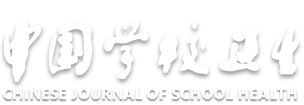Status and associations of nutritional and dietary behaviors of school-age children in poor areas of western China
-
摘要:
目的 了解中国西部贫困地区学生营养与饮食行为现状及其关联,为中学生营养不良持续改善策略提供参考。 方法 2020年10—12月对陕西和四川共3个贫困县1 887名小学生进行体格测量和饮食行为问卷调查,采用混合效应模型分析营养状况与饮食行为的相关性。 结果 1 887名学生生长迟缓、消瘦、超重肥胖、中心型肥胖检出率分别为1.8%,6.6%,27.7%,24.5%,省份间差异均有统计学意义(χ2值分别为94.76,46.05,109.96,80.50,P值均 < 0.05)。陕西、四川学生超重肥胖检出率分别为32.8%,4.9%;生长迟缓和消瘦检出率陕西为0.4%,4.7%,四川为8.1%,14.7%。1 160名学生饮食行为分析结果显示每天吃早餐、蛋、奶等的学生比例偏低;关联分析结果显示,每天吃早餐与学生超重肥胖风险呈负相关(OR=0.26,P < 0.05),每周食用外卖和在食堂就餐2~6次与学龄儿童消瘦均呈正相关(OR值分别为2.51,2.82,P值均 < 0.05)。 结论 中国西部贫困地区小学生存在营养不足和营养过剩并存情况,且呈现地区差异。应采取针对性措施改善学生营养状况。 Abstract:Objective To investigate the status of nutrition and dietary behaviors and their associations in school-age children in poor areas of western China, to provide clues for sustainable improvement strategies of malnutrition among primary school students in rural revitalization. Methods A total of 1 887 school-age students from 3 poverty-stricken counties in Shaanxi and Sichuan provinces were investigated by physical examination and questionnaire survey during October to December in 2020. Mixed-effects model was used to analyze associations between nutritional status and dietary behaviors. Results The prevalence of stunting, wasting, overweight and obesity, and central obesity among 1 887 students were 1.8%, 6.6%, 27.7%, 24.5%, respectively, and the differences between two provinces were statistically significant (χ2=94.76, 46.05, 109.96, 80.50, P < 0.05). The prevalence of overweight and obesity of students in Shaanxi and Sichuan were 32.8% and 4.9%, respectively. The prevalence of stunting and wasting were 0.4% and 4.7% in Shaanxi, and 8.1% and 14.7% in Sichuan, respectively. Among 1 160 students with complete dietary data, the proportions of students who ate breakfast, eggs, and milk daily were low, and eating breakfast daily was negatively associated with overweight and obesity(OR=0.26, P < 0.05), and eating out and eating in canteen were positively associated with wasting(OR=2.51, 2.82, P < 0.05). Conclusion School-age children in poor areas of western China are facing double burden of malnutrition, and there are significant regional differences. Future targeted interventions should be made to improve these students' nutritional status. -
Key words:
- Nutritional status /
- Food habits /
- Body mass index /
- Child /
- Poverty areas
1) 利益冲突声明 所有作者声明无利益冲突。2) 吴妍与高利旺为共同第一作者。 -
表 1 中国西部贫困地区不同特征学生营养状况检出率比较
Table 1. Comparison of nutritional status of students with different characteristics in poor areas of western China
组别 选项 人数 生长迟缓 消瘦 超重肥胖 中心型肥胖 检出人数 χ2值 P值 检出人数 χ2值 P值 检出人数 χ2值 P值 检出人数 χ2值 P值 性别 男 981 17(1.7) 0.05 0.82 68(6.9) 0.43 0.51 312(31.8) 17.05 < 0.01 293(29.9) 31.36 < 0.01 女 906 17(1.9) 56(6.2) 211(23.3) 170(18.8) 省份 四川 346 28(8.1) 94.76 <0.01 51(14.7) 46.05 <0.01 17(4.9) 109.96 <0.01 20(5.8) 80.50 <0.01 陕西 1 541 6(0.4) 73(4.7) 506(32.8) 443(28.8) 地区 清涧 1 149 5(0.4) 94.81 < 0.01 62(5.4) 49.24 < 0.01 374(32.6) 110.15 < 0.01 317(27.6) 83.77 < 0.01 子洲 392 1(0.3) 11(2.8) 132(33.7) 126(32.1) 冕宁 346 28(8.1) 51(14.7) 17(4.9) 20(5.8) 学校 1 214 2(0.9) 98.32 < 0.01 12(5.6) 54.09 < 0.01 78(36.5) 116.08 < 0.01 77(36.0) 104.73 < 0.01 2 935 3(0.3) 50(5.4) 296(31.7) 240(25.7) 3 201 1(0.5) 6(3.0) 59(29.4) 52(25.9) 4 191 0 5(2.6) 73(38.2) 74(38.7) 5 98 6(6.1) 19(19.4) 6(6.1) 11(11.2) 6 248 22(8.9) 32(12.9) 11(4.4) 9(3.6) 年级 一 160 0 10.97 0.05 6(3.8) 9.68 0.09 51(31.9) 14.80 0.01 43(26.9) 7.68 0.18 二 370 5(1.4) 36(9.7) 88(23.8) 79(21.4) 三 401 14(3.5) 28(7.0) 99(24.7) 89(22.2) 四 399 7(1.8) 24(6.0) 123(30.8) 111(27.8) 五 405 7(1.7) 22(5.4) 106(26.2) 97(24.0) 六 152 1(0.7) 8(5.3) 56(36.8) 44(29.0) 注:学校1~6分别代表 6所学校;()内数据为检出率/%。 表 2 中国西部贫困地区学生饮食行为与营养状况关联性分析(n=1 160)
Table 2. Analysis of the associations between dietary behaviors and nutritional status of students in poor areas of western China(n=1 160)
自变量 选项 消瘦 超重肥胖 中心型肥胖 生长迟缓 OR值(95%CI) P值 OR值(95%CI) P值 OR值(95%CI) P值 OR值(95%CI) P值 每天吃早餐 是 0.96(0.12~1.99) 0.97 0.26(0.10~0.65) < 0.01 0.32(0.13~0.81) 0.02 - 每周吃新鲜水果/次 ≤1 1.33(0.49~3.57) 0.57 0.73(0.39~1.35) 0.31 0.68(0.36~1.28) 0.23 7.51(0.65~87.21) 0.12 2~6 0.97(0.46~2.03) 0.94 0.82(0.57~1.18) 0.29 0.78(0.54~1.14) 0.20 4.19(0.48~36.49) 0.19 每周吃外卖/次 2~6 2.51(1.08~5.82) 0.03 1.04(0.58~1.86) 0.90 1.18(0.65~2.13) 0.59 1.11(0.12~9.98) 0.93 ≥7 2.90(0.53~2.23) 0.99 1.09(0.06~2.12) 0.95 1.12(0.06~20.4) 0.94 - 每周吃油炸食品/次 2~6 0.92(0.52~1.63) 0.78 1.12(0.79~1.57) 0.52 1.27(0.89~1.80) 0.18 1.61(0.61~4.25) 0.33 ≥7 0.63(0.07~5.55) 0.68 0.83(0.29~2.42) 0.74 1.02(0.35~3.00) 0.97 - 每周在食堂就餐/次 2~6 2.82(1.38~3.73) <0.01 1.04(0.69~1.57) 0.83 1.16(0.76~1.77) 0.48 8.94(0.39~57.36) 0.82 ≥7 0.03(0.39~2.56) 0.99 1.34(0.44~4.14) 0.61 1.66(0.54~5.12) 0.38 - 每周在食品摊就餐/次 2~6 1.03(0.52~2.03) 0.94 0.80(0.54~1.18) 0.26 0.70(0.47~1.05) 0.09 0.60(0.16~2.33) 0.46 ≥7 2.64(0.28~4.77) 0.39 0.93(0.20~4.33) 0.93 0.96(0.20~4.62) 0.96 3.30(0.85~8.01) 0.07 注:采用混合效应模型,调整混杂因素为年龄、性别、父母职业、父母学历、户籍类型、家庭收入;每天吃早餐以否为对照,每周吃新鲜水果频率以每天吃为对照,每周外卖、油炸食品、食堂就餐、食品摊就餐频率均以≤1次为对照。 -
[1] 陈京蓉, 熊鹰, 杨静, 等. 2013—2019年重庆市贫困农村地区中小学生营养不良状况分析[J]. 公共卫生与预防医学, 2021, 32(1): 43-46. https://www.cnki.com.cn/Article/CJFDTOTAL-FBYF202101011.htmCHEN J R, XIONG Y, YANG J, et al. Analysis of malnutrition status among primary and middle school students in poor rural areas of Chongqing from 2013 to 2019[J]. J Public Health Prev Med, 2021, 32(1): 43-46. (in Chinese) https://www.cnki.com.cn/Article/CJFDTOTAL-FBYF202101011.htm [2] 赵静珺, 王辛. 陕西省2015年农村学生营养状况调查[J]. 中国学校卫生, 2017, 38(7): 1069-1071. doi: 10.16835/j.cnki.1000-9817.2017.07.032ZHAO J J, WANG X. Survey on the nutrition status of rural students in Shaanxi Province in 2015[J]. Chin J Sch Health, 2017, 38(7): 1069-1071. (in Chinese) doi: 10.16835/j.cnki.1000-9817.2017.07.032 [3] 王烁, 董彦会, 王政和, 等. 1985—2014年中国7~18岁学生超重与肥胖流行趋势[J]. 中华预防医学杂志, 2017, 51(4): 300-305. https://www.cnki.com.cn/Article/CJFDTOTAL-XZEK201702014.htmWANG S, DONG Y H, WANG Z H, et al. Trends in overweight and obesity among Chinese children of 7-18 years old during 1985-2014[J]. Chin J Prev Med, 2017, 51(4): 300-305. (in Chinese) https://www.cnki.com.cn/Article/CJFDTOTAL-XZEK201702014.htm [4] GAO L W, MA L, XUE H, et al. A 3-year longitudinal study of effects of parental perception of children's ideal body image on child weight change: the childhood obesity study in China mega-cities[J]. Prev Med, 2020, 132: 105971. doi: 10.1016/j.ypmed.2019.105971 [5] 国家卫生健康委员会. 学龄儿童青少年超重与肥胖筛查: WS/T 586—2018[S]. 北京: 中国标准出版社, 2018.National Health Commission of the PRC. Screening for overweight and obesity among school-age children and adolescents: WS/T 586-2018[S]. Beijing: Standards Press of China, 2018. (in Chinese) [6] 国家卫生计生委员会. 学龄儿童青少年营养不良筛查: WS/T 456—2014[S]. 北京: 中国标准出版社, 2014.National Health Commission of the PRC. Screening standard for malnutrition of school-age children and adolescents: WS/T 456-2014[S]. Beijing: Standards Press of China, 2014. (in Chinese) [7] 王友发, 孙明晓, 杨月欣. 中国肥胖预防和控制蓝皮书[M]. 北京: 北京大学医学出版社, 2019.WANG Y F, SUN M X, YANG Y X. Chin Blue Paper on obesity prevention and control[M]. Beijing: Peking University Medical Press, 2019. (in Chinese) [8] 董彦会, 王政和, 杨招庚, 等. 2005年至2014年中国7~18岁儿童青少年营养不良流行现状及趋势变化分析[J]. 北京大学学报(医学版), 2017, 49(3): 424-432. https://www.cnki.com.cn/Article/CJFDTOTAL-BYDB201703009.htmDONG Y H, WANG Z H, YANG Z G, et al. Epidemic status and secular trends of malnutrition among children and adolescents aged 7-18 years from 2005 to 2014 in China[J]. J Peking Univ(Health Sci), 2017, 49(3): 424-432. (in Chinese) https://www.cnki.com.cn/Article/CJFDTOTAL-BYDB201703009.htm [9] 国家卫生健康委员会. 中国居民营养与慢性病状况报告(2020年)[J]. 营养学报, 2020, 42(6): 521. https://www.cnki.com.cn/Article/CJFDTOTAL-ZLBJ202102011.htmNational Health Commission of the PRC. The nutrition and chronic disease status report of Chinese residents(2020)[J]. Acta Nutr Sinca, 2020, 42(6): 521. (in Chinese) https://www.cnki.com.cn/Article/CJFDTOTAL-ZLBJ202102011.htm [10] 徐粒子, 孟灿, 魏亚男, 等. 2019年安徽省经济落后农村地区小学生营养现况及其影响因素分析[J]. 中国健康教育, 2021, 37(6): 487-491. https://www.cnki.com.cn/Article/CJFDTOTAL-ZGJK202106003.htmXU L Z, MENG C, WEI Y N, et al. Analysis on nutritional status and its influencing factors among primary school students in economically back-ward rural areas of Anhui Province, 2019[J]. Chin J Health Educ, 2021, 37(6): 487-491. (in Chinese) https://www.cnki.com.cn/Article/CJFDTOTAL-ZGJK202106003.htm [11] SANTOS C, BUSTAMANTE A, HEDEKER D, et al. Correlates of overweight in children and adolescents living at different altitudes: the Peruvian health and optimist growth study[J]. J Obes, 2019, 2019: 1-11. [12] 张倩, 关炳菊, 王情情, 等. 农村贫困地区小学生早餐现状[J]. 中国学校卫生, 2017, 38(8): 1138-1141, 1145. doi: 10.16835/j.cnki.1000-9817.2017.08.006ZHANG Q, GUAN B J, WANG Q Q, et al. The breakfast status of primary school students in poor rural area[J]. Chin J Sch Health, 2017, 38(8): 1138-1141, 1145. (in Chinese) doi: 10.16835/j.cnki.1000-9817.2017.08.006 [13] MIN J, ZHAO Y, SLIVKA L, et al. Double burden of diseases worldwide: coexistence of undernutrition and overnutrition-related non-communicable chronic diseases[J]. Obes Rev, 2018, 19(1): 49-61. [14] 白彩琴, 卞伟, 杨杰. 山西省贫困地区中小学生膳食营养状况3次调查比较[J]. 现代预防医学, 2019, 46(12): 2149-2153. https://www.cnki.com.cn/Article/CJFDTOTAL-XDYF201912009.htmBAI C Q, BIAN W, YANG J. Three surveys on nutritional status of primary and secondary school in poverty-stricken counties of Shanxi[J]. Mod Prev Med, 2019, 46(12): 2149-2153. (in Chinese) https://www.cnki.com.cn/Article/CJFDTOTAL-XDYF201912009.htm [15] 张晓帆, 李荔, 许娟, 等. 2016年"农村义务教育学生营养改善计划"学生早餐饮奶与营养状况的关系[J]. 中华流行病学杂志, 2019, 40(2): 175-179.ZHANG X F, LI L, XU J, et al. Associations between milk intake at breakfast and nutritional status of students attending the Nutrition Improvement Program for Rural Compulsory Education Students in 2016[J]. Chin J Epidemiol, 2019, 40(2): 175-179. (in Chinese) [16] 刘应洁, 周慧敏, 王士然, 等. 2019年贵州省某市少数民族地区农村中小学生营养状况与早餐行为的关联性[J]. 卫生研究, 2021, 50(4): 552-557. https://www.cnki.com.cn/Article/CJFDTOTAL-WSYJ202104005.htmLIU Y J, ZHOU H M, WANG S R, et al. Relationship between nutritional status and breakfast behaviors of rural primary and middle school students in a minority area of a city in Guizhou Province in 2019[J]. J Hyg Res, 2021, 50(4): 552-557. (in Chinese) https://www.cnki.com.cn/Article/CJFDTOTAL-WSYJ202104005.htm [17] YAGUCHI-TANAKA Y, TABUCHI T. Skipping breakfast and subsequent overweight/obesity in children: a nationwide prospective study of 2. 5 to 13-year-old children in Japan[J]. J Epidemiol, 2021, 31(7): 417-425. [18] ARDESHIRLARIJANI E, NAMAZI N, JABBARI M, et al. The link between breakfast skipping and overweight/obesity in children and adolescents: a Meta-analysis of observational studies[J]. J Diabetes Metab Disord, 2019, 18(2): 657-664. [19] ABOUCHACRA S, ALKAABI J, NAIR S C, et al. Adolescent eating behaviors in the UAE: time to intervene[J]. J Family Med Prim Care, 2021, 10(8): 2998-3004. [20] ZHENG J, GAO L, XUE H, et al. Eating-out behaviors, associated factors and associations with obesity in Chinese school children: findings from the childhood obesity study in China mega-cities[J]. Eur J Nutr, 2021, 60(6): 3003-3012. [21] 高原, 何丽. 我国餐饮从业人员健康素养现状分析[J]. 中国健康教育, 2018, 34(6): 553-556. https://www.cnki.com.cn/Article/CJFDTOTAL-ZGJK201806017.htmGAO Y, HE L. Status analysis on health literacy among Chinese catering staff[J]. Chin J Health Educ, 2018, 34(6): 553-556. (in Chinese) https://www.cnki.com.cn/Article/CJFDTOTAL-ZGJK201806017.htm [22] 段晓霞, 廖宇婷, 黄金城, 等. 成都市外卖餐饮从业者营养素养水平及其与套餐营养素的相关性[J]. 中国医学科学院学报, 2021, 43(1): 77-81. https://www.cnki.com.cn/Article/CJFDTOTAL-ZYKX202101015.htmDUAN X X, LIAO Y T, HUANG J C, et al. Associations between takeaway food nutrients and nutritional literacy of takeaway platform practitioners in Chengdu[J]. Acta Acad Med Sinca, 2021, 43(1): 77-81. (in Chinese) https://www.cnki.com.cn/Article/CJFDTOTAL-ZYKX202101015.htm -

 点击查看大图
点击查看大图
计量
- 文章访问数: 599
- HTML全文浏览量: 207
- PDF下载量: 157
- 被引次数: 0





 下载:
下载: